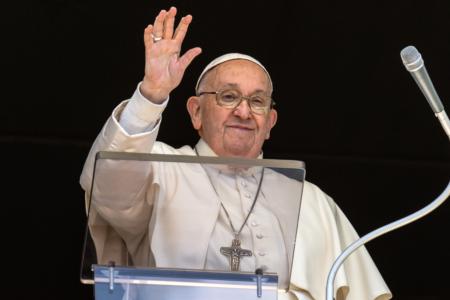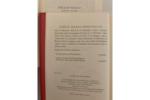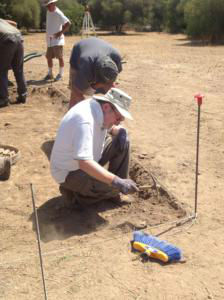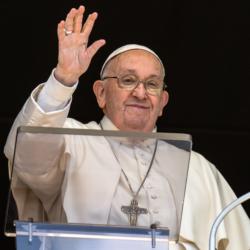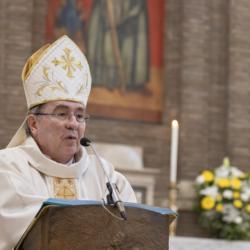University of Portland team helps in study of Mallorca's ancient graves
PORTLAND, Ore. (CNS) -- On July 18, a team from the University of Portland labored in the heat with archaeologists on the island of Mallorca, in the Mediterranean off the coast of Spain.
On an abandoned Mallorcan farm, crews had dug a trench just over 6 feet wide by 16 feet long.
On that morning, the scientists, theologians and workers were thrilled to find just what they were looking for -- an ancient Christian grave. About 1,500 years ago, the quiet field was a burial ground for Christians from the Roman naval city of Pollentia.
The Oregon Catholic university's team was led by Holy Cross Father Richard Rutherford, retired theology professor, and included chemists Ray and Ronda Bard, Holy Cross Father Ron Wasowski of the environmental studies department and six helpers.
They gathered with archaeologists from the University of Barcelona, Spain, to toast the successful survey and mapping of the cemetery, which had been led by Rachel Thurston, a surveyor and graduate of the University of Portland's master of arts in pastoral ministry program. The territorial governor of Mallorca congratulated the Oregon team on its work and invited the group to a reception at the palace in Palma.
Future trips will map out the rest of the graveyard -- which could have hundreds of graves -- and look for a long-buried church compound.
"Christians didn't just bury their dead and run off," said Father Rutherford, an expert in early baptism and funeral practices. "If there is a cemetery, there is a church somewhere."
Father Rutherford has been researching ancient baptisteries for years and one trip took him to Mallorca, where he met the Spanish archeological team studying ancient Pollentia, which translated means "power." The promise was great for locating unstudied graves and churches, so Father Rutherford marshaled his group from Oregon.
The University of Portland team took a new survey to locate evidence of the graves then marked out a grid to pinpoint locations. Ray Bard conducted chemical analysis on soil and artifacts, such as pottery shards, using a portable X-ray fluorescence spectrometer. Elements on the ground can offer clues to daily life in ancient times. For example, did they work with iron? How did they glaze their pottery?
Father Wasowski took aerial images, using a helium balloon and a small University of Portland drone. He was looking for changes in vegetation that might indicate graves or even the ruins of a church. On future trips, he expects to use an infrared camera that will yield more evidence.
Phoenicians came to Mallorca as early as the eighth-century B.C. The Romans assumed control after the Second Punic War and began settlements in 123 B.C., founding Pollentia as a navy garrison.
When Christianity swept the Roman Empire in the fourth and fifth centuries A.D., Pollentia's Christian population grew. Vandals captured the island and held it for about 40 years, but Roman rule was re-established in 465. It was after the Byzantine conquest in 534 that Christianity flourished and many churches and graveyards were built.
Muslim forces from North Africa began attacking in the eighth century and by the 10th century had taken possession. By the 13th century, instability in the Moorish caliphate created an opening and a massive Spanish force besieged the island for almost a year, taking it in 1230. Old Pollentia was disassembled and rebuilt and expanded nearby, creating the medieval walled city of Alcudia, which today is a popular tourist site.
In the turmoil, the old Christian cemetery of Pollentia was covered and lost. It became a farm.
About 30 graves had been excavated and studied in the 1920s but farmers covered them over at the start of the Spanish Civil War to create an arable field. Mallorca was a nationalist stronghold and amid the turmoil, no one did extensive research on the old Christian site. It was not until this past July that the graves were seen again.
"There is so little known," Father Rutherford told the Catholic Sentinel, newspaper of the Portland Archdiocese. For example, it is not clear what sort of Christians lived on Pollentia. Were they from the Roman tradition? Byzantines? Arian heretics?
The priest, who taught at the University of Portland for more than 35 years, is building what he calls the Christian Antiquities Initiative, a partnership of scholars, students and supporters, to study ancient sites. Already, UP professors and students are beginning to plan projects at Pollentia. One biology professor and student will examine remains from the graves to see what kind of diseases hit the island city.
- - -
Editor's Note: A podcast on Pollentia Expedition with Father Rutherford is available here: http://tinyurl.com/pmt59ln. A related blog is available here: https://wordpress.up.edu/pollentia.
- - -
Langlois is a staff writer at the Catholic Sentinel, newspaper of the Archdiocese of Portland.
